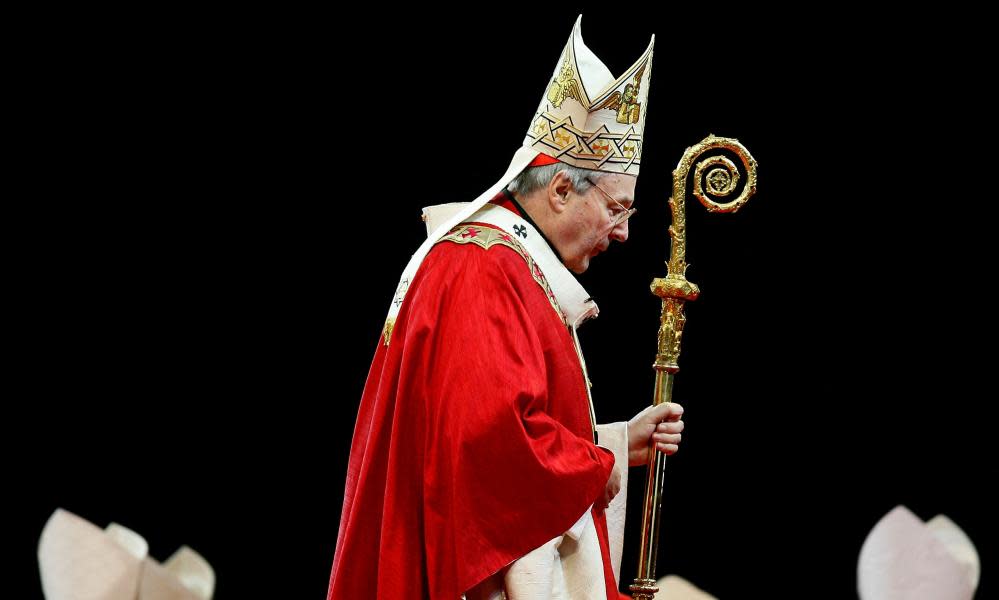Police seek court order to stop LGBTQ+ protesters marching outside George Pell’s funeral

Police are seeking a court order to prevent LGBTQ+ protesters from marching on the street outside of St Mary’s Cathedral on the day of George Pell’s funeral.
Community Action for Rainbow Rights, a Sydney-based campaign group, had planned to protest through Sydney to St Mary’s on Thursday, the day of Pell’s requiem mass, to denounce his strident and long-held opposition to same-sex marriage and LGBTQ+ rights.
But the Guardian has seen court documents showing that NSW police are seeking an order in the NSW supreme court to prevent them from marching outside the cathedral.
Police are seeking the order in the NSW supreme court to prohibit the holding of a public assembly. The police commissioner can seek to block public assemblies under section 25 of the state’s summary offences act.
April Holcombe, Community Action for Rainbow Rights co-convener, said the police stance was baffling.
Documents show the activist group sought a permit on 23 January to hold a public assembly of about 300 people, meeting at Hyde Park fountain in the morning, walking along College Street past St. Mary’s Cathedral, turning left up Liverpool St and continuing up Oxford Street until Taylor Square.
“We’re not at all proposing to enter the space where the funeral is happening or even to disrupt it,” Holcombe told the Guardian. “We’re just saying that on the road next to the cathedral we’re going to be marching past in a peaceful procession as part of a route that takes us up to Taylor Square.
“They’ve just said no.”
NSW police said in a statement that it held “safety concerns” about the protest.
“The NSW Police Force has received a Form 1 for a protest planned for Thursday 2 February in Sydney CBD, however, despite attempted negotiations with organisers, safety concerns associated with their proposed assembly cannot be adequately mitigated without amendments to the proposal,” a spokesperson said.
“As such, the Commissioner will apply to the NSW Supreme Court to prohibit the assembly.”
The spokesperson said police recognised and supported free speech and peaceful assembly, but that “first priority is always the safety of the wider community”.
The Guardian also revealed earlier this month that another form of protest – the tying of ribbons in commemoration of abuse victims – was also being blocked outside of St Mary’s.
Survivors and their supporters have been tying ribbons to the fence surrounding the cathedral in the lead up to Pell’s funeral. But they are being routinely removed by church staff.
Myself & Ballarat CSA survivors Paul & Trevor hope you can join us tomorrow (Weds) @ 7.30am in the St Mary's Cathedral forecourt for a decorating event, Get thee to a $2 shop to buy some ribbons *today*! #EveryRibbonHasAVoice
if on FB please share : https://t.co/StUCazbdnN pic.twitter.com/lQiDeizlOP— Pauline Pantsdown (@PPantsdown) January 31, 2023
Francis Sullivan, the former head of the Catholic church’s Truth Justice and Healing Council, told the Guardian the removal of the ribbons appeared designed to prevent the scandal from being “associated with Cardinal [George] Pell” in the days leading up to his funeral.
“It does come down to the administrators of [each building] so, by the sounds of things, they’re taking a view that they’re not going to permit ribbons on the fences,” he said. “You can only assume that it’s because they don’t want the scandal associated with Cardinal Pell. That’s the only way you can read it, in my mind.”
Paul Auchettl, an abuse survivor from Ballarat, flew to Sydney on the weekend to tie ribbons at St Mary’s.
“In this sense, ribbons are sacred, they should not be cut down or taken,” Auchettl said, prior to his arrival in Sydney.
“If you go up to someone who’s tying a ribbon, they’ll tell you exactly why they’re doing it: the ribbons have become a powerful voice for people who were silenced for so long.
“I don’t want to be disrespectful at George’s funeral, I want him to have a peaceful service. But I want to alert people that there is this unfinished business that he was still yet to do and that, in a sense, he has failed.”
Church staff have repeatedly removed the ribbons that he and others were tying to the fence.
The practice of tying ribbons to the fence originated in Ballarat, at St Patrick’s cathedral. After initially removing them, the church has since allowed the ribbons to remain.

 Yahoo Movies
Yahoo Movies 
